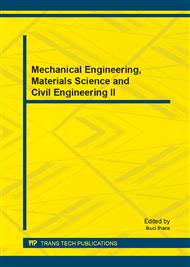p.1003
p.1007
p.1011
p.1015
p.1020
p.1024
p.1028
p.1034
p.1039
Development of Energy Finite Element Analysis in Vibration Analysis of Composite Laminate Plate Structures
Abstract:
The high frequency vibration analysis of a composite laminate plate structure subjected to impact loads was investigated by using method of energy finite element analysis (EFEA). The time and space averaged energy density was used as the primary variable to form the governing differential equations. The multilayer laminate plate is simplified to be equivalent isotropic plate using the average concept, such as the average damping loss factor and the average group speed. The global system of EFEA equations can be solved numerically and the energy density distribution within the whole system can then be obtained. The EFEA numerical results for composite laminate plate structure were validated through comparison with those of very dense conventional finite element analysis (FEA).
Info:
Periodical:
Pages:
1020-1023
Citation:
Online since:
December 2013
Authors:
Price:
Сopyright:
© 2014 Trans Tech Publications Ltd. All Rights Reserved
Share:
Citation:


